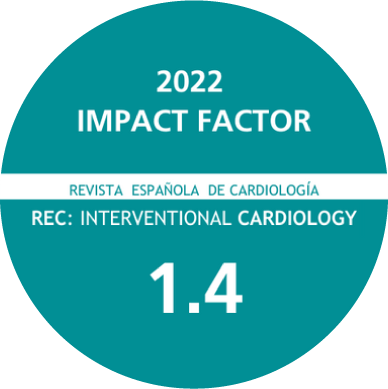Original articles \ Valvulopathy
Fluoroscopic and tomographic correlation for aortic annulus measurements in transcatheter aortic valve implantation: “follow the right cusp” rule
aDepartment of Cardiology, Deutsches Herzzentrum München, Technische Universität München, Munich, Germany
bHospital de Cardiología, Centro Médico Nacional Siglo XXI, Instituto Mexicano del Seguro Social (IMSS), Mexico City, Mexico
cDepartment of Cardiology, University Heart Center, University Hospital Zurich, Zurich, Switzerland
dDZHK (German Center for Cardiovascular Research), Partner Site Munich Heart Alliance, Munich, Germany
eInstitut für Anästhesiologie, Deutsches Herzzentrum München, Technische Universität München, Munich, Germany
fCoordinación de Innovación en Salud, Instituto Mexicano del Seguro Social, Mexico City, Mexico
REC Interv Cardiol. 2023;5:193-202
Prospective assessment of clinical outcomes of transcatheter aortic valve implantation in a cohort of patients based on their risk profile
aDepartamento de Cardiología, Hospital Universitario Virgen de la Arrixaca, Murcia, Spain
bAccounting Department, Servicio Regional de Salud, Murcia, Spain
cEdwards Lifesciences, Valencia, Spain
dHealth Services Research Centre, Akershus University Hospital, Lørenskog, Norway
eAxentiva Solutions, Oviedo, Spain
REC Interv Cardiol. 2023;5:102-109
Transcatheter aortic valve implantation using Evolut PRO versus SAPIEN 3 valves: a randomized comparative trial
a Cardiology Department, Assiut University Heart Hospital, Assiut University, Assiut, Egypt
b Cardiology Department, Duisburg Heart Center, Duisburg, Germany
c Cardiac Surgery Department, Duisburg Heart Center, Duisburg, Germany
REC Interv Cardiol. 2023;5:94-101
Cost-effectiveness of SAPIEN 3 transcatheter aortic valve implantation in low surgical mortality risk patients in Spain
aServicio de Cardiología, Complejo Hospitalario Universitario A Coruña, Instituto de Investigación Biomédica de A Coruña (INIBIC), Universidad de A Coruña, A Coruña, Spain
bCentro de Investigación Biomédica en Red de Enfermedades Cardiovasculares (CIBERCV), Madrid, Spain
cServicio de Cardiología, Hospital Universitario Virgen de la Arrixaca, El Palmar, Murcia, Spain
dDepartamento de Cardiología, Hospital Ramón y Cajal, Madrid, Spain
eServicio de Cardiología, Hospital Universitario de Toledo, Toledo, Spain
fUnidad de Cardiología y Cirugía Cardiovascular, Hospital Universitario Virgen del Rocío, Seville, Spain
gServicio de Cardiología, Hospital Universitari Vall d’Hebron, Barcelona, Spain
hEdwards Lifesciences, Nyon, Switzerland
iYork Health Economics Consortium, University of York, York, United Kingdom
REC Interv Cardiol. 2023;5:38-45
Outcomes of transcatheter aortic valve implantation in Spain through the Activity Registry of Specialized Health Care
aServicio de Cardiología, Hospital Álvaro Cunqueiro, Vigo, Pontevedra, Spain
bServicio de Cardiología, Hospital Universitario Marqués de Valdecilla, Santander, Spain
cDirección Médica, Hospital Universitario del Henares, Madrid, Spain
dEdwards Lifesciences, Valencia, Spain
eAxentiva Solutions, Barcelona, Spain
REC Interv Cardiol. 2022;4:123-131
Simple option for large access vascular closure in case of failed suture-based closure device after TAVI
aDepartment of Internal Medicine I, St.-Johannes-Hospital, Dortmund, Germany
bDepartment of Internal Medicine, Carl von Ossietzky University Oldenburg, Germany
cDepartment of Cardiothoracic Surgery, St.-Johannes-Hospital, Dortmund, Germany
REC Interv Cardiol. 2022;4:33-38
Outcomes of nonagenarians after transcatheter aortic valve implantation
aServicio de Cardiología, Instituto Clínic Cardiovascular, Hospital Clínic, Barcelona, Spain
bServicio de Cardiología y Servicio de Cirugía Cardíaca, Hospital General Universitario de Valencia, Valencia, Spain
cServicio de Cardiología, Hospital Universitario de Cruces, Baracaldo, Bizkaia, Spain
dServicio de Cardiología, Hospital Puerta de Hierro, Majadahonda, Madrid, Spain
eServicio de Cardiología, Hospital Clínico Universitario de Valladolid, Valladolid, Spain
fServicio de Cardiología y Servicio de Cirugía Cardíaca, Hospital Universitario y Politécnico La Fe, Valencia, Spain
gServicio de Cardiología, Hospital Universitario de Badajoz, Badajoz, Spain
hServicio de Cardiología, Hospital Germans Trias i Pujol, Badalona, Barcelona, Spain
iServicio de Cardiología, Hospital General Universitario de Alicante, Alicante, Spain
jServicio de Cardiologia, Policlínica Gipuzkoa, San Sebastián, Guipúzcoa, Spain
kServicio de Cardiología, Hospital Universitario de Basurto, Bilbao, Bizkaia, Spain
lServicio de Cardiología, Hospital Álvaro Cunqueiro, Vigo, Pontevedra, Spain
mServicio de Cardiología, Hospital Universitario Miguel Servet, Zaragoza, Spain
nServicio de Cardiología, Hospital Clínico Universitario Virgen de la Arrixaca, El Palmar, Murcia, Spain
oServicio de Cardiología, Hospital Universitari de Bellvitge, L’Hospitalet de Llobregat, Barcelona, Spain
pServicio de Cardiología, Hospital Universitario de León, León, Spain
qServicio de Cardiología, Hospital Universitario de La Princesa, Madrid, Spain
rServicio de Cardiología, Hospital Regional Universitario de Málaga, Málaga, Spain
sServicio de Cardiología, Hospital Clínico Universitario de Valencia, Valencia, Spain
tServicio de Cardiología, Hospital Universitario Fundación Jiménez Díaz, Madrid, Spain
uServicio de Cardiología, Hospital Universitario Doce de Octubre, Madrid, Spain
vServicio de Cardiología, Hospital Universitario Virgen Macarena, Sevilla, Spain
wServicio de Cardiología, Complejo Hospitalario de Toledo, Toledo, Spain
xServicio de Cirugía Cardíaca, Hospital Virgen de la Victoria, Málaga, Spain
yCentro de Investigación Biomédica en Red de Enfermedades Cardiovasculares (CIBERCV), Spain
REC Interv Cardiol. 2021;3:250-257
Outcomes of emergency compared to elective TAVI: a meta-analysis
aServicio de Cardiología, Hospital Clínico Universitario de Valladolid, Instituto de Ciencias del Corazón (ICICOR), Valladolid, Spain
bCentro de Investigación Biomédica en Red de Enfermedades Cardiovasculares (CIBERCV), Spain
REC Interv Cardiol. 2021;3:166-174
Percutaneous and surgical aortic valve replacement. Impact of volume and type of center on results
aServicio de Cardiología, Instituto de Investigación Sanitaria del Hospital Clínico San Carlos (IdISSC), Madrid, Spain
bFundación Instituto para la Mejora de la Asistencia Sanitaria (IMAS), Madrid, Spain
cServicio de Control de Gestión, Hospital Universitario 12 de Octubre, Instituto de Investigación I+12, Madrid, Spain
dServicio de Medicina Preventiva y Estadística, Instituto de Investigación Sanitaria del Hospital Clínico San Carlos (IdISSC), Madrid, Spain
eServicio de Cardiología, Hospital Álvaro Cunqueiro, Vigo, Pontevedra, Spain
REC Interv Cardiol. 2021;3:103-111

